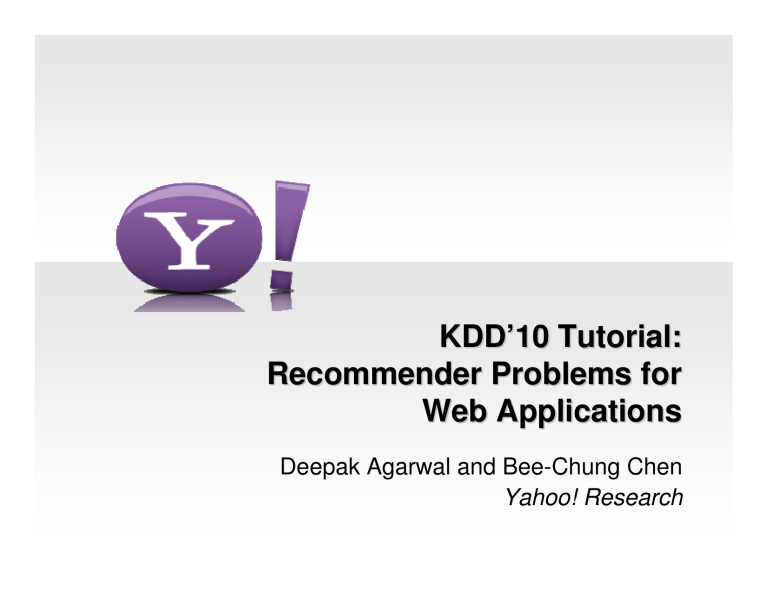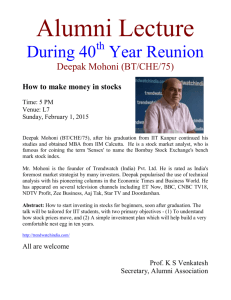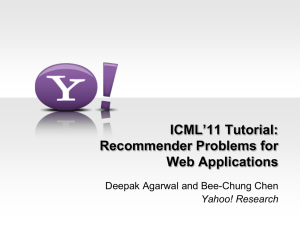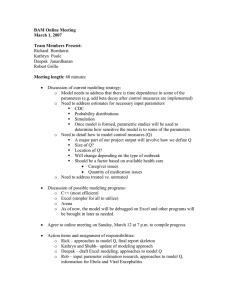KDD`10 Tutorial: Recommender Problems for Web Applications

KDD ’ ’ 10 Tutorial:
Deepak Agarwal and Bee-Chung Chen
Yahoo! Research
Agenda
• Focus:
– Recommender problems for dynamic , time sensitive applications
• Content Optimization
• Introduction (20 min, Deepak)
– Content optimization, match-making, example applications
• Offline components (40 min, Deepak)
– Collaborative filtering (CF), methods for cold-start
• Online components + initialization (70 min, Bee-Chung)
– Time-series, online/incremental methods, explore/exploit (bandit)
• Evaluation methods (15 min, Deepak)
• Challenges (5 min, Deepak)
Deepak Agarwal & Bee-Chung Chen @ KDD’10 2
Content Optimization
• Goal
– Effectively and “pro-actively” learn from user interactions with content that are displayed to maximize our objectives.
• A new scientific discipline at the interface of
– Large scale Machine Learning & Statistics
• Offline Models
• Online Models
• Collaborative Filtering
• Explore/Exploit
– Multi-Objective Optimization in the presence of Uncertainty
• Click-rates (CTR), Engagement,….
– User Understanding
• Profile construction
– Content Understanding
• Topics, “aboutness”, entities, follow-up of something, breaking news,…
Deepak Agarwal & Bee-Chung Chen @ KDD’10 3
Content Optimization: High level flowchart
• Flow
– Understand content (Offline)
– Serve content to optimize our objectives (Online)
– quickly learn from feedback obtained using ML/Statistics (Offline +
Online)
– Constantly enhance our content inventory to improve future performance (Offline)
– Constantly enhance our user understanding to improve future performance (Offline + Online)
– Iterate
Deepak Agarwal & Bee-Chung Chen @ KDD’10 4
Some examples
• Simple version
– I have an important module on my page, content inventory is obtained from a third party source which is further refined through editorial oversight. Can I algorithmically recommend content on this module? I want to drive up total CTR on this module
• More advanced
– I got X% lift in CTR. But I have additional information on other downstream utilities (e.g. dwell time). Can I increase downstream utility without losing too many clicks?
• Highly advanced
– There are multiple modules running on my website. How do I take a holistic approach and perform a simultaneous optimization?
Deepak Agarwal & Bee-Chung Chen @ KDD’10 5
Recommend applications
Deepak Agarwal & Bee-Chung Chen @ KDD’10
Recommend search queries
Recommend packages:
Image
Title, summary
Links to other pages
Pick 4 out of a pool of K
K = 20 ~ 40
Dynamic
Routes traffic other pages
Recommend news article
6
Problems in this example
• Optimize CTR on different modules together in a holistic way
– Today Module, Trending Now, Personal Assistant, News, Ads
– Treat them as independent?
• For a given module
– Optimize some combination of CTR, downstream engagement and perhaps revenue.
Deepak Agarwal & Bee-Chung Chen @ KDD’10 7
Single module CTR optimization problem
• Display “best” articles for each user visit
• Best - Maximize User Satisfaction, Engagement
– BUT Hard to obtain quick feedback to measure these
• Approximation
– Maximize utility based on immediate feedback (click rate) subject to constraints (relevance, freshness, diversity)
• Inventory of articles?
– Created by human editors
– Small pool (30-50 articles) but refreshes periodically
Deepak Agarwal & Bee-Chung Chen @ KDD’10 8
Recommendation: A Match-making Problem
• Recommendation problems
• Search: Web, Vertical
• Online advertising
• …
Item Inventory
Articles, web page, ads, …
Opportunity
Users, queries, pages, …
Deepak Agarwal & Bee-Chung Chen @ KDD’10
Use an automated algorithm to select item(s) to show
Get feedback (click, time spent,..)
Refine the models
Repeat (large number of times)
Measure metric(s) of interest
(Total clicks, Total revenue,…)
9
Important Factors affecting solution in Match-making Problems
• Items: Articles, web pages, ads, modules, queries, users, updates, etc.
• Opportunities: Users, query keywords, pages, etc.
• Metric (e.g., editorial score, CTR, revenue, engagement)
– Currently, most applications are single-objective
– May be multi-objective optimization (maximize X subject to Y , Z ,..)
• Properties of the item pool
– Size (e.g., all web pages vs. 40 stories)
– Quality of the pool (e.g., anything vs. editorially selected)
– Lifetime (e.g., mostly old items vs. mostly new items)
Deepak Agarwal & Bee-Chung Chen @ KDD’10 10
Factors affecting Solution continued
• Properties of the opportunities
– Pull: Specified by explicit, user-driven query (e.g., keywords, a form)
– Push: Specified by implicit context (e.g., a page, a user, a session)
– Size (e.g., user base); continuity (e.g., session vs. single event)
• Properties of the feedback on the matches made
– Types and semantics of feedback (e.g., click, vote)
– Latency (e.g., available in 5 minutes vs. 1 day)
– Volume (e.g., 100K per day vs. 300M per day)
• Constraints specifying legitimate matches
(e.g., business rules)
• Available Metadata
(e.g., link graph, various user/item attributes)
Deepak Agarwal & Bee-Chung Chen @ KDD’10 11
Recommendation vs. Other Match-Making Problems
Main Metric
Items
Opportunities
Examples
Recommendation
User engagement
Anything
(except for ads)
Push (implicit)
The system guesses users info needs
Recommend articles, friends, feeds to users
Recommend related items given an item
Search
Relevance to the query
Anything
(except for ads)
Pull (explicit)
Users specify their info needs
Web search
Vertical search
Advertising
Revenue
Ads
Push
Sponsored search
Content match
Behavior targeting
Display advertising
(non-guaranteed)
Deepak Agarwal & Bee-Chung Chen @ KDD’10 12
More on Recommendation vs. Search
• Recommendation
– User intent: See something “interesting” (browse mode, implicit)
• The system tries to guess what a user likes on an entity/topic page
– No query reformulation (unless we suggest related topics/entities)
– False +ve more costly than false –ve
• Showing a bad article is a worse than missing a good one
• Search
– User intent: Explicit, users express what they want
– Users can reformulate queries
– False –ve more costly (but depends on the query)
• Users want to get the results they are looking for
Deepak Agarwal & Bee-Chung Chen @ KDD’10 13
Modeling: Key components
Offline
(Logistic, GBDT,..)
Feature construction
Content: IR, clustering, taxonomy, entity,..
User profiles: clicks, views, social, community,..
Initialize
Online
(Fine resolution
Corrections)
(item, user level)
(Quick updates)
Explore/Exploit
(Adaptive sampling)
Deepak Agarwal & Bee-Chung Chen @ KDD’10 14
Modeling Problems that has received attention
• Univariate response (e.g. click); single objective (e.g. maximize CTR)
• Our solution
– Initialize online through offline models
– Learn “corrections” to offline models at very granular levels (user, item) and learn rapidly in an online fashion
– Online correction models have reduced dimension through clever representations of parameters and by exploiting the fallback mechanism to coarser models
– The models are tightly coupled with Explore-exploit to ensure fast convergence to areas of high valued response
Deepak Agarwal & Bee-Chung Chen @ KDD’10 15
Currently in production powered by some methods discussed in this tutorial
Deepak Agarwal & Bee-Chung Chen @ KDD’10
3 4
Recommend packages:
Image
Title, summary
Links to other pages
Pick 4 out of a pool of K
K = 20 ~ 40
Dynamic
Routes traffic other pages
17
Problem definition
• Display “best” articles for each user visit
• Best - Maximize User Satisfaction, Engagement
– BUT Hard to obtain quick feedback to measure these
• Approximation
– Maximize utility based on immediate feedback (click rate) subject to constraints (relevance, freshness, diversity)
• Inventory of articles?
– Created by human editors
– Small pool (30-50 articles) but refreshes periodically
Deepak Agarwal & Bee-Chung Chen @ KDD’10 18
Where are we today?
• Before this research
– Articles created and selected for display by editors
• After this research
– Article placement done through statistical models
• How successful ?
"Just look at our homepage, for example. Since we began pairing our content optimization technology with editorial expertise, we've seen click-through rates in the Today module more than double. ----- Carol Bartz, CEO Yahoo! Inc (Q4,
2009)
Deepak Agarwal & Bee-Chung Chen @ KDD’10 19
Main Goals
• Methods to select most popular articles
– This was done by editors before
• Provide personalized article selection
– Based on user covariates
– Based on per user behavior
• Scalability: Methods to generalize in small traffic scenarios
– Today module part of most Y! portals around the world
– Also syndicated to sources like Y! Mail, Y! IM etc
Deepak Agarwal & Bee-Chung Chen @ KDD’10 20
Similar applications
• Goal: Use same methods for selecting most popular, personalization across different applications at Y!
• Good news! Methods generalize, already in use
Deepak Agarwal & Bee-Chung Chen @ KDD’10 21
Next few hours
Most Popular
Recommendation
Offline Models
Online Models Time-series models
Intelligent Initialization Prior estimation
Explore/Exploit Multi-armed bandits
Personalized
Recommendation
Collaborative filtering
(cold-start problem)
Incremental CF, online regression
Prior estimation, dimension reduction
Bandits with covariates
Deepak Agarwal & Bee-Chung Chen @ KDD’10 22



